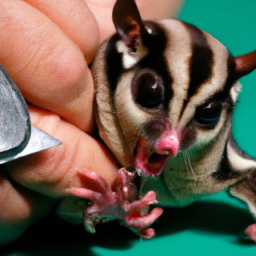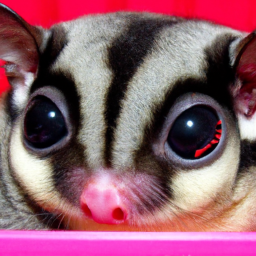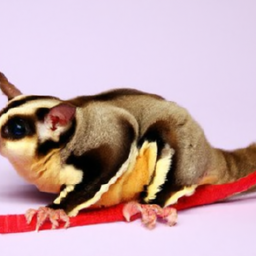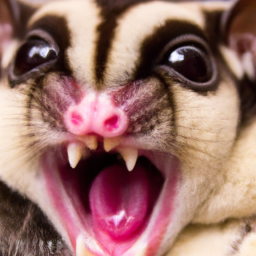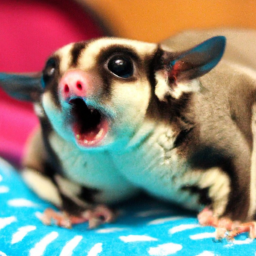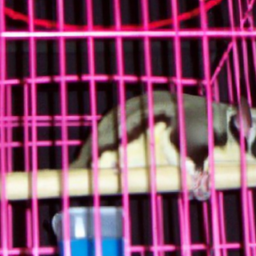How Do You Stop A Sugar Glider From Biting
Greetings! Are you struggling with a sugar glider that won’t stop biting? Don’t worry, you’re not alone! In this article, we’ll explore some helpful strategies and techniques to address this issue. We understand that dealing with a biting sugar glider can be frustrating and even painful, but with a little patience and understanding, you can establish a harmonious relationship with your furry friend.
If you want to learn more about how to stop a sugar glider from biting, you’ve come to the right place! Throughout this article, we’ll delve into the reasons behind their biting behavior and provide you with effective methods to prevent and manage it. From understanding their natural instincts to implementing proper handling techniques, we’ll cover all the bases to help you create a safe and enjoyable environment for both you and your sugar glider. So, let’s dive in and discover the secrets to a bite-free friendship with your adorable little companion!
How Do You Stop A Sugar Glider From Biting
Understanding Sugar Gliders
Sugar gliders, also known as Petaurus breviceps, are small, adorable marsupials native to the forests of Australia, Indonesia, and New Guinea. With their large eyes and ability to glide through the air, they have become popular exotic pets in recent years. However, one common issue that sugar glider owners may face is biting. In this article, we will explore different strategies to prevent biting and foster a positive relationship with your pet.
What are Sugar Gliders?
Sugar gliders are social creatures that thrive in groups, making them highly sociable and affectionate pets when properly cared for. They earn their name from their preference for sweet foods, such as nectar, fruit, and sap. While they primarily glide from tree to tree in the wild, captive sugar gliders enjoy climbing, exploring, and interacting with their human caregivers.
Behavior of Sugar Gliders
It is important to understand the behavior of sugar gliders to effectively address biting. In the wild, these animals live in colonies and establish strong bonds within their groups. When taken into captivity, they need to form similar connections with their human caregivers. However, they may exhibit biting behavior due to fear, stress, or territoriality.
Common Reasons for Biting
There are several reasons why sugar gliders may resort to biting. These include:
-
Fear and mistrust: Sugar gliders have a natural instinct to defend themselves when they feel threatened. They may bite if they perceive the approaching hand as a potential threat.
-
Stress and anxiety: Changes in their environment, such as loud noises or sudden movements, can cause stress and lead to biting.
-
Lack of socialization: Sugar gliders that have not been adequately socialized may exhibit fearful behavior, including biting.
-
Territoriality: Sugar gliders are protective of their personal space. If they feel their territory is being invaded, they may resort to biting.
Creating a Safe Environment
To prevent biting, it is essential to create a safe and comfortable environment for your sugar glider. Here are some tips on how to achieve this:
Providing Adequate Space
Sugar gliders require a spacious habitat to exercise and explore. A cage with dimensions of at least 24″x24″x36″ is recommended for a single glider, with extra space for each additional glider. Make sure the cage is equipped with secure locks to prevent any escapes.
Climbing and Play Areas
Sugar gliders are active creatures that enjoy climbing and playing. To keep them entertained, provide plenty of branches, ropes, and toys for them to climb on and explore. This will help alleviate boredom and reduce the likelihood of biting out of frustration.
Hiding Spots and Nests
Sugar gliders are known to be nocturnal animals, so it is important to provide them with hiding spots and nests where they can rest during the day. These can include pouches, tunnels, or enclosed spaces within the cage where they can retreat when they feel the need for privacy or security.
Bonding and Building Trust
Creating a strong bond with your sugar glider is crucial in preventing biting incidents. Here are some techniques to help you build trust:
Patience and Consistency
Sugar gliders are naturally curious but can also be hesitant when it comes to trusting humans. Patience is key when trying to build a bond with your pet. Regular, consistent handling sessions can help them become familiar with your presence and scent. Start with short sessions and gradually increase the duration over time.
Hand-Feeding and Treats
A great way to build trust and positive associations is by hand-feeding your sugar glider. Offer a variety of treats, such as small pieces of fruit or their favorite insects, from your hand. This not only helps to create a positive bond but also encourages them to see your hand as a source of something enjoyable rather than a threat.
Quiet and Calm Interactions
Sugar gliders are sensitive creatures that can become nervous or stressed in loud or chaotic environments. When interacting with your glider, choose a quiet and calm space free from distractions. Speak softly and move slowly to keep them at ease. Avoid sudden movements that may startle them and lead to defensive behavior.
Recognizing Warning Signs
Being able to recognize warning signs of aggression, fear, or stress is crucial in preventing biting incidents. Keep an eye out for the following indicators:
Aggressive Posture and Vocalizations
When feeling threatened or aggressive, sugar gliders may adopt a defensive posture. This can include baring their teeth, flattening their bodies against a surface, or making hissing or growling sounds. If you notice these behaviors, it is important to give them space and avoid any further interaction until they calm down.
Tail Position and Movements
The position and movements of your sugar glider’s tail can also provide insights into their emotional state. A relaxed and still tail is a good sign, indicating contentment. However, a raised or twitching tail may indicate agitation or discomfort. If you observe these signs, it is important to proceed with caution and avoid actions that may escalate their anxiety.
Signs of Fear or Stress
Sugar gliders may display various signs of fear or stress, including excessive grooming, freezing in place, or attempting to hide. They may also exhibit defensive behaviors such as lunging or biting if they feel trapped or overwhelmed. It is crucial to respect their boundaries and create a calm and secure environment to alleviate these signs of distress.
Handling Techniques
Proper handling techniques are vital to preventing biting and creating a positive experience for both you and your sugar glider. Keep the following tips in mind when handling your pet:
Proper Handling Approach
Approach your sugar glider with a calm and gentle demeanor. Avoid making sudden movements or startling them, as this can lead to defensive behavior. Allow them to approach you on their terms and offer them your hand to sniff and investigate before attempting to pick them up.
Safe and Secure Gripping
When picking up your sugar glider, it is essential to grasp them firmly yet gently to prevent them from escaping or feeling insecure. Support their body by placing one hand under their chest and the other hand under their hindquarters. Avoid placing pressure on their delicate limbs or tail, as this can lead to injury or discomfort.
Avoiding Sudden Movements
During handling, it is crucial to avoid sudden movements that may startle or scare your sugar glider. These creatures are naturally cautious, and any abrupt actions may trigger a defensive response. Move slowly and gracefully, allowing them to adjust to your presence and movements.
Training and Discipline
Training and discipline play a role in preventing biting and encouraging desirable behavior in sugar gliders. Here are some strategies you can implement:
Positive Reinforcement
Sugar gliders respond well to positive reinforcement. Reward good behavior with treats, praise, or gentle strokes. This helps them associate positive experiences with desirable actions, making them more likely to repeat those behaviors in the future.
Redirecting Behavior
If your sugar glider displays behavior that may lead to biting, such as nibbling or nipping, it is important to redirect their attention. Offer them an appropriate chew toy or treat to divert their focus away from unwanted behaviors. Consistency is key in reinforcing this redirection technique.
Discouraging Biting
If your sugar glider does bite, it is essential to react calmly and assertively without resorting to punishment or negative reinforcement. Gently pull back your hand while expressing a firm “no” to let them know that biting is unacceptable. Provide them with an alternative behavior to exhibit, such as licking or grooming your fingers, and reward them for the appropriate response.
Seeking Professional Help
If you are facing persistent biting issues with your sugar glider or need additional guidance, it may be beneficial to seek professional help. Consider the following options:
Consulting an Exotic Pet Veterinarian
An exotic pet veterinarian with experience in sugar gliders can provide valuable insights and guidance on handling and behavior modification techniques. They can assess your glider’s health and offer recommendations tailored to your specific situation.
Working with a Sugar Glider Trainer
Enlisting the help of a professional sugar glider trainer can also be beneficial, especially if you are struggling with training or bonding. These trainers specialize in understanding sugar glider behavior and can provide you with customized training plans and tips to address biting and other behavioral issues.
Joining Support Groups
Another valuable resource for sugar glider owners are support groups or online communities. These groups allow you to connect with other glider owners who may have faced similar challenges and can offer advice, support, and reassurance. They can provide a wealth of knowledge and practical tips to prevent biting and foster a healthy relationship with your sugar glider.
Health Considerations
Maintaining the health of your sugar glider is paramount to ensuring their overall well-being and reducing the likelihood of biting. Consider the following health-related aspects:
Regular Veterinary Check-ups
Regular veterinary check-ups are crucial for monitoring the health of your sugar glider. A qualified exotic pet veterinarian can perform routine examinations, provide vaccinations if necessary, and address any health concerns. Early detection and treatment of underlying health issues can help prevent discomfort or pain that may contribute to biting behavior.
Understanding Dental Issues
Sugar gliders have unique dental requirements, and dental problems can lead to irritability and biting. Ensure your glider’s diet includes appropriate foods for dental health, such as hard fruits, vegetables, and specialized dental treats. Regular dental check-ups and teeth cleanings may also be necessary to maintain good oral health.
Preventing Malnutrition
A balanced and nutritious diet is essential for the health of your sugar glider. Ensure they receive a well-rounded diet consisting of fresh fruits, vegetables, protein, and appropriate supplements. Consult an exotic pet veterinarian or a sugar glider nutritionist to ensure you are providing the correct nutritional requirements for your pet.
Common Mistakes to Avoid
To successfully prevent biting incidents, it is important to avoid common mistakes that may exacerbate the issue. Here are some things to steer clear of:
Punishment and Negative Reinforcement
Using punishment or negative reinforcement when dealing with biting behavior can have adverse effects on your sugar glider’s trust and overall well-being. Avoid yelling, hitting, or any actions that may cause distress or fear. Instead, focus on positive reinforcement and redirecting unwanted behaviors.
Neglecting Socialization and Enrichment
Sugar gliders thrive on social interaction and mental stimulation. Neglecting these aspects can lead to boredom, anxiety, and increased biting tendencies. Make sure to spend quality time bonding with your glider, providing opportunities for play and exploration, and enriching their environment with toys, puzzles, and climbing structures.
Overlooking Health Problems
Biting can sometimes be a result of underlying health issues. It is important to monitor your sugar glider’s overall health, observe any changes in behavior or appetite, and seek veterinary care promptly when necessary. Ignoring or dismissing potential health problems can worsen their condition and contribute to biting behavior.
Can Cleaning the Sugar Glider’s Cage Affect Its Behavior and Biting Habits?
Cleaning sugar glider cage materials is crucial in maintaining their health and behavior. A dirty cage can lead to stress and unsanitary conditions, possibly affecting their behavior and increasing the likelihood of biting. Regularly cleaning the cage and using appropriate materials can help in preventing negative changes in their behavior.
Can A Sugar Glider’s Biting Behavior Transmit Diseases to Humans?
Yes, sugar gliders can transmit illnesses through their biting behavior. While the risk is low, it is possible for them to pass on diseases like salmonella and other bacterial infections. It’s important to handle sugar gliders carefully and seek medical attention if bitten to prevent any potential health risks.
Conclusion
Successfully preventing biting in sugar gliders requires patience, understanding, and consistent effort. By creating a safe environment, building trust through bonding, recognizing warning signs, utilizing proper handling techniques, and implementing positive reinforcement training, you can foster a positive relationship with your sugar glider. Remember to prioritize their health, seek professional assistance when needed, and avoid common mistakes that may exacerbate biting behavior. With time and dedication, you can enjoy a harmonious and fulfilling companionship with your adorable sugar glider.
